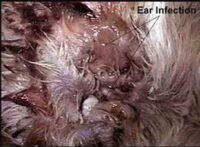True Story a Zoonotic Disease Transferred Animal to Human
by Diane Baron Taylor

What is a zoonotic disease?
A zoonotic disease is a disease that is transferable from animals to humans. There are hundreds of zoonotic diseases and they can be passed on to us in many different ways. For example, I contracted a bacterial infection called Pseudomonas Aeruginosa three years ago by inhaling the dander of an infected dog. Other ways they can be passed on to humans are through scratches, bites, contact with urine and feces, or ingestion.
What is Pseudomona?
Dr. Ted Liou, an Associate Professor of Internal Medicine at the University of Utah, defined Pseudomonas simply as a “professional pathogen; an organism that feels its job is to go out and infect things.”
With simple nutrient requirements, it proliferates rapidly once it finds a host. It is a gram negative rod bacterium, mostly found in plants, soil, water, animals, and humans. These bacteria have the ability to get into your eyes and ears, wounds, burns, urinary tract, and respiratory system. Eventually, they can get into your bloodstream, where they can become fatal. Canine Pseudomona skin infections usually result as a secondary infection to staphylococcus. Ears are the most common place to find this infection.
How can you get it?
Skin to skin contact can spread Pseudomonas. They also have the ability to be aerosolized, making particles small enough to be inhaled and absorbed by our mucous membranes. This happens during drying, when bacteria, yeast, and fungus are forced into the air that we breathe. Zoonotic pathogens can also be spread through the contaminated uniforms of healthcare workers, who play with their animals before they go to work.
What are the symptoms & how is it diagnosed?
Pseudomona has a sickly sweet odor, similar to rotting fruit. When I was infected, this was my first sign. Other symptoms include a yellow or greenish mucus, pain, pressure, or swelling of the face. A mucus culture is needed to confirm diagnosis.
How is it treated?
Pseudomona is a bio film. It has a protective slimy outer coating, which makes it difficult for antibiotics to penetrate. Oral antibiotics and sinus flushes are often tried first. Intravenous antibiotics may also be prescribed. Balloon Sinuplasty is a new, less invasive surgery, as well as setting medicinal stents in the sinuses, where they drip medicine directly onto the affected areas. The stents are easily removed after thirty days.
What precautions can be taken?
The best precaution is to wear a mask when drying dogs or other animals, since this is when skin particles are most likely to be in the air. I recommend the masks from Breathe Healthy; they fit snugly and make a secure seal. You should also flush your sinuses after grooming, using a netti pot, a saline rinse bottle, or a hydro-pulse irrigation system. And always wear gloves. They will help protect your hands from possible infections.
I have learned a lot since my infection. It has been an interesting journey. I have seen more than thirty doctors over the past three years—many of whom were skeptical of my symptoms. It took a year and a half to get a Psuedomonas diagnosis and three years to find a doctor who knew how to treat this type of infection. It has taught me how to be proactive and persistent.
I am currently being treated for complications resulting from my infection. I have lost most of my sense of taste and smell, and have been diagnosed with Eustachian Tube Dysfunction, (ETD). However, a new surgery for ETD has just become available. By having this surgery, I’m hopeful my facial pain will finally be relieved. The most important thing that I have learned, however, is to not be afraid to turn away clients. Now, when I see an animal that belongs in the Veterinarian’s office, I make that recommendation before grooming it. It is definitely not worth the risk. ▲
 Diane Baron Taylor and her husband Robb live in Logan, Utah with their lab/mix Stinkers, and for more than twenty years, they have owned and operated The Doggy Boutique Pet Salon. At the age of twenty-two, Diane was raising and grooming American Cocker Spaniels. She was unaware at the time that professional dog groomers existed. Diane found the only groomer in town, and asked if she needed help at her shop, and lucky for Diane, she did. After working for three years, Diane opened her own shop. This allowed her to work from home and spend time with her children. Her first shop was in a small room in her mobile home. When they purchased a home, she made the entire basement a grooming salon, and now she employs six groomers. With her health improving, the whole family is working to expand the business, which will soon include a pet hotel and daycare facilities. Her favorite time of the year is January, when the Pet-Pro Cruise sails on another warm and fun adventure!
Diane Baron Taylor and her husband Robb live in Logan, Utah with their lab/mix Stinkers, and for more than twenty years, they have owned and operated The Doggy Boutique Pet Salon. At the age of twenty-two, Diane was raising and grooming American Cocker Spaniels. She was unaware at the time that professional dog groomers existed. Diane found the only groomer in town, and asked if she needed help at her shop, and lucky for Diane, she did. After working for three years, Diane opened her own shop. This allowed her to work from home and spend time with her children. Her first shop was in a small room in her mobile home. When they purchased a home, she made the entire basement a grooming salon, and now she employs six groomers. With her health improving, the whole family is working to expand the business, which will soon include a pet hotel and daycare facilities. Her favorite time of the year is January, when the Pet-Pro Cruise sails on another warm and fun adventure!


